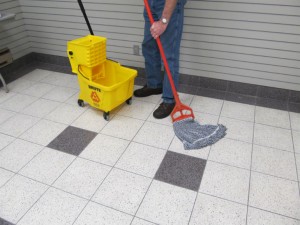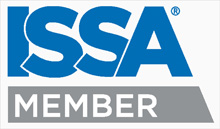Floor Care: Proper Mopping Procedures
 When it comes to floor care, proper maintenance is key. Proper floor maintenance keeps your floor cleaner and safer for longer, lengthens the period between strips, and ultimately reduces maintenance costs, all the while making your facility look much nicer.
When it comes to floor care, proper maintenance is key. Proper floor maintenance keeps your floor cleaner and safer for longer, lengthens the period between strips, and ultimately reduces maintenance costs, all the while making your facility look much nicer.
One of the most common floor maintenance tasks is daily mopping. This is often considered a very simple task and is therefore sometimes not even trained on, meaning that mopping can often be performed incorrectly. Incorrect mopping procedures often do not make the floor any cleaner and can sometimes be detrimental to the appearance of the floor.
Here are some simple tips to get the most out of mopping.
Wet mopping vs. Damp mopping
A big problem with many mopping procedures is that not enough cleaning solution is being used. Damp mopping should only be used for spot cleaning. When cleaning the entire floor, make sure the mop is head completely wet, and do not wring it out before applying to the floor. This ensures the proper amount of cleaning solution is on the floor, it will not dry out in spots, and there is ample time and contact to effectively remove soils from the floor.
Changing mop heads
There are two instances where mop heads are used incorrectly. In the first instance, the mop head is used for such a long period of time that it becomes fully loaded with soil. At this point the mop is no longer cleaning and removing the soil, but just spreading the soil evenly over the floor. In the second instance, a mop head is used in several different areas, and cross-contaminating between different soils. For example, using a mop in a kitchen to pick up grease and then using the same mop head in a general area for normal soils. The mop head will be loaded with grease and will not be as effective at picking up other types of soils. Changing mop heads appropriately will ensure your mopping procedure is effective.
Many soils can become caked on or ground into the floor, making them more difficult to remove. When mopping, the more agitation that is applied the better. You can use brushes such as deck brushes to apply agitation on hard-to-remove soils to ensure that the floor becomes completely clean.
Changing cleaning solution
The cleaning chemical solution in your mop bucket should not be visibly soiled and darkened. If you are using dirty water to mop the floor, the floor will not become any cleaner than the water used to clean it is. The cleaning solution should be changed often, as soon as it becomes visibly dirty. This ensures clean solution is applied to the floor, making it more effective.
Using the correct mop
You should always use looped-end mops or microfiber mops to perform cleaning, not cut-end mops. Cut-end mops, although they are less expensive, are far less effective. They leave lint particles on the floor, leave gaps in the mop path, and can not be laundered. Looped-end mops last around 8 times as long as cut-end mops and are much more effective at cleaning.
By following these simple tips, you can improve your mopping procedures, resulting in cleaner, safer floors that require less long-term maintenance.
For more information on floor care products and processes, visit Multi-Clean’s floor care webpage.


